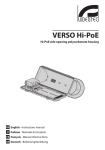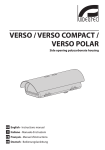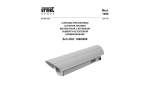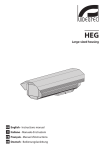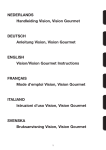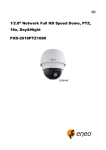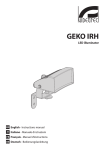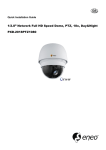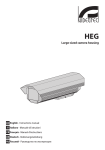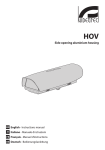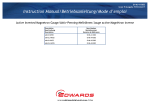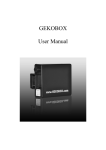Download VERSO Hi-PoE IPM
Transcript
VERSO Hi-PoE IPM Polycarbonate housing with IPM technology for IP cameras EN English - Instructions manual IT Italiano - Manuale di istruzioni FR Français - Manuel d’instructions DE Deutsch - Bedienungslanleitung VERSO Hi-PoE IPM Polycarbonate housing with IPM technology for IP cameras EN English - Instructions manual Contents ENGLISH 1 About this manual.......................................................................................................... 3 1.1 Typographical conventions................................................................................................................................... 3 2 Notes on copyright and information on trademarks................................................... 3 3 Safety rules..................................................................................................................... 3 4 Identification................................................................................................................... 4 4.1 Product description and type designation..................................................................................................... 4 4.2 Product markings..................................................................................................................................................... 4 5 Preparing the product for use....................................................................................... 4 5.1 Unpacking and contents........................................................................................................................................ 4 5.1.1 Unpacking................................................................................................................................................................................... 4 5.1.2 Contents....................................................................................................................................................................................... 4 5.2 Safely disposing of packaging material............................................................................................................ 4 6 Assembling and installing............................................................................................. 5 6.1 Installation................................................................................................................................................................... 5 6.1.1 How to open the housing...................................................................................................................................................... 5 6.1.2 Removal of the slide................................................................................................................................................................ 5 6.1.3 Installation of the cable glands........................................................................................................................................... 5 6.1.4 Installation of the GEKO IRH illuminator (optional)...................................................................................................... 5 6.1.5 Brackets and adaptors............................................................................................................................................................ 6 6.1.1 Installation of the version with double filter for air renewal..................................................................................... 6 6.1.2 Ethernet cable installation.................................................................................................................................................... 6 6.1.3 How to install the camera...................................................................................................................................................... 7 6.1.4 Connection of the GEKO IRH illuminator (optional).................................................................................................... 7 6.1.5 PoE cable connection.............................................................................................................................................................. 8 6.1.6 Connection of the blower with double filter for air renewal (optional)............................................................... 8 7 Configuration.................................................................................................................. 8 8 Switching on................................................................................................................... 9 9 Maintaining and cleaning............................................................................................ 10 9.1 Maintaining...............................................................................................................................................................10 9.1.1 Kit for upgrading of the systems.......................................................................................................................................10 9.2 Cleaning.....................................................................................................................................................................10 9.2.1 Window and plastic cover cleaning (PC)........................................................................................................................10 10 Disposal of waste materials....................................................................................... 11 11 Technical data............................................................................................................. 11 11.1 General.....................................................................................................................................................................11 11.2 Mechanical..............................................................................................................................................................11 11.1 Electrical..................................................................................................................................................................11 11.2 Environment..........................................................................................................................................................11 11.3 Certifications..........................................................................................................................................................11 12 Technical drawings..................................................................................................... 12 1 About this manual 1.1 Typographical conventions DANGER! Explosion hazard. Read carefully to avoid danger of explosion. DANGER! High level hazard. Risk of electric shock. Disconnect the power supply before proceeding with any operation, unless indicated otherwise. WARNING! Medium level hazard. This operation is very important for the system to function properly. Please read the procedure described very carefully and carry it out as instructed. INFO Description of system specifications. We recommend reading this part carefully in order to understand the subsequent stages. The manufacturer declines all responsibility for any damage caused by an improper use of the appliances mentioned in this manual. Furthermore, the manufacturer reserves the right to modify its contents without any prior notice. The documentation contained in this manual has been collected with great care, the manufacturer, however, cannot take any liability for its use. The same thing can be said for any person or company involved in the creation and production of this manual. • The device must be installed only and exclusively by qualified technical personnel. • Before any technical work on the appliance, disconnect the power supply. • Do not use power supply cables that seem worn or old. • Never, under any circumstances, make any changes or connections that are not shown in this handbook. Improper use of the appliance can cause serious hazards, risking the safety of personnel and of the installation. • Use only original spare parts. Non-original spare parts could cause fire, electrical discharge or other hazards. 2 Notes on copyright and information on trademarks • Before proceeding with installation check the supplied material to make sure it corresponds to the order specification by examining the identification labels (4.2 Product markings, page 4). The quoted names of products or companies are trademarks or registered trademarks. • Power supply to the product must be exclusively provided by the PoE cable (Power over Ethernet). • This device was designed to be permanently installed on a building or on a suitable structure. • When installing the device, comply with all the national standards. • Any device which could be installed inside the product must comply with the current safety standards. 3 Instructions manual - English - EN Before installing and using this unit, please read this manual carefully. Be sure to keep it handy for later reference. 3 Safety rules EN - English - Instructions manual • If the installation is NEMA TYPE 4X, the installer must replace the cable glands of the product with NEMA TYPE 4X cable glands. • For all connections, use cables that are able to withstand temperatures of at least 75°C (167°F). • The product is designed to house only cameras that are properly certified. 5 Preparing the product for use Any change that is not expressly approved by the manufacturer will invalidate the guarantee. 4 Identification 5.1 Unpacking and contents 4.1 Product description and type designation 5.1.1 Unpacking The VERSO Hi-PoE IPM housing exploits in an optimal way the POE and Hi-POE technology, using the power supplied by the Ethernet cable as the sole source of power for all the devices connected, thus ensuring the maximum efficiency and flexibility of the network system as well as user-friendly installation and low costs. When the product is delivered, make sure that the package is intact and that there are no signs that it has been dropped or scratched. If there are obvious signs of damage, contact the supplier immediately. Keep the packaging in case you need to send the product for repairs. 5.1.2 Contents The innovative IPM (Intelligent Power Management) system enables extremely quick and easy installation with the use of a single Ethernet connecting cable. Check the contents to make sure they correspond with the list of materials as below: The Hi-POE IPM system automatically detects all the options, like heating, fan and illuminator and then autonomously balances the power to ensure suitable distribution of the same to the connected devices. This guarantees the optimal operation of the IP camera between -30°C (-22°F) and +60°C (140°F), with heat regulation and cold start (activation at low temperature). • RJ45 wiring The analog system, with previously installed camera housings, can be retrofitted on IPM system simply by changing the slide and the internal electronics. This enables the digital conversion, speeding up the installation and thereby minimizing costs and environmental impact. Very easy to install thanks to the side opening system that allows the full access to the camera, lenses and all internal connections. 4.2 Product markings See the label attached to the product. 4 • Housing • Housing equipment: • Allen wrench • Spacers • Cable glands gaskets • Cable glands (x3) • Bolts and screws • Screws for camera • Instructions manual 5.2 Safely disposing of packaging material The packaging material can all be recycled. The installer technician will be responsible for separating the material for disposal, and in any case for compliance with the legislation in force where the device is to be used. When returning a faulty product we recommend using the original packaging for shipping. 6 Assembling and installing 6.1.3 Installation of the cable glands The product may be interfaced with devices not manufactured by VIDEOTEC. VIDEOTEC recommends a test prior to installation. VIDEOTEC will not be liable for any installation costs or lost revenues in the event a compatibility problem will occur. 6.1 Installation Inside the supply are 3 cable glands that must be installed at the bottom of the housing as shown in figure. The cable glands that are not used must be sealed with the cap to avoid water entering the housing. 6.1.1 How to open the housing Loosen the 2 screws on the side, turn the cover and the upper half of the body about the opening hinge axis. Fig. 1 Fig. 3 6.1.2 Removal of the slide 6.1.4 Installation of the GEKO IRH illuminator (optional) To remove the slide it is necessary to unscrew the fixing screws as shown in figure. Maximum power of the illuminator must not exceed 6W. To install the illuminator it is necessary to use the illuminator bracket (OSUPPIR). The kit must be bought separately. Use the cable glands or the smallest sealing ring to avoid water entering the housing. Fig. 2 For installation information on the illuminator on housing refer to the product's use and installation manual. For further details on configuration and use refer to the relative chapter (6.1.4 Connection of the GEKO IRH illuminator (optional), page 7). 5 Instructions manual - English - EN For the internal cable routing brackets it is necessary to use the sealing ring kit (OWBIP). The reduced space does not allow the use of the supplied cable glands. The kit must be bought separately. The assembly and installation must be performed only by skilled personnel. 6.1.2 Ethernet cable installation The product cannot be fixed to a bracket or adaptor. For further information refer to the product's technical data sheet or directly contact VIDEOTEC. Insert the Ethernet cable in the gasket and block it as shown in figure. 6.1.1 Installation of the version with double filter for air renewal Special attention must be paid to the position of the air intake filter fins when installing the housing. Fig. 6 Fit the gasket (01) to the cable gland M20 (02). Fasten the cable gland to the bottom of the housing (03) using the M20 nut (04). Pay attention to the fixing. Tightening torque: 7Nm max. Pass the cable with connector RJ45 (05) through the M20 cable gland (02). Tighten the cable gland plug (06). Fig. 4 04 Depending on the inclination of the housing, the direction of the fins must be such to prevent water entering in case of rain. 45° 45° 6 Maximal rotation on the transversal axis: 0°. Maximal inclination on the longitudinal axis: +/- 45˚. 02 06 03 Fig. 7 Fig. 5 01 05 To guarantee the IP44 weatherproof, install the housing on the support following the inclination limits as shown in the picture. 0˚ EN - English - Instructions manual 6.1.5 Brackets and adaptors 6.1.3 How to install the camera Connect the illuminator to the J6 terminal as described in the diagram below. 1 It is possible to install only PoE type cameras. 2 3 Instructions manual - English - EN The correct device working, in the stated temperature range, is guaranteed with the use of camera and lens with temperature from -10°C up to +60°C. 6.1.4 Connection of the GEKO IRH illuminator (optional) 4 Mount the camera using the supplied screws (01) and spacers (02). Apply at least one spacer to guarantee electrical isolation between the slide and the camera. Position the camera lens close to the glass to avoid visual interference or optical reflections. Connect the camera to the J2 connector (PoE OUT) with the supplied cable (03). Fig. 10 Connection of the GEKO IRH illuminator 03 02 01 Illuminator Terminal J6 Brown (telemetry) 1 Blue (telemetry) 2 White (supply) 3 Black (supply) 4 Tab. 1 To adjust the lighting threshold of the illuminator refer to the product's use and installation manual. Fig. 8 Refit the slide in its housing and fix the screws and washers previously removed. Fig. 9 7 6.1.5 PoE cable connection EN - English - Instructions manual Connect the PoE cable from the Power Injector to the J1 connector. 7 Configuration Before powering the device, you must set the maximum power consumption of the housing operating on dip switch SW1. Fig. 11 Before powering the device, you must set the maximum power consumption of the housing operating on dip switch SW1 (7 Configuration, page 8). 6.1.6 Connection of the blower with double filter for air renewal (optional) Connect the fan cable to the J4 connector. Fig. 13 Absorbed power configuration SW1 Maximum power OFF PoE class 3 (13W max) ON Hi-PoE class 4 (25W max) Tab. 2 According to the absorbed power, the system can supply the options described in the table (Tab. 3, page 9). Fig. 12 8 VERSO Hi PoE IPM Available models and features Injector Camera Demisting system Illuminator Heating Fan with double air filter -10°C / +60°C (14°F / 140°F) PoE classe 3 (13W) PoE max. class 2 (7W) p – – p Hi-PoE class 4 (25W) PoE max. class 3 (13W) p p – p PoE classe 3 (13W) PoE max. class 2 (7W) p – – – Hi-PoE class 4 (25W) PoE max. class 3 (13W) p p – – Hi-PoE class 4 (25W) PoE max. class 3 (13W) p – p – -10°C / +50°C (14°F / 122 F°) -30°C / +50°C (-22°F / +122°F) Tab. 3 8 Switching on The 6 LEDs shown in the figure allow to check the product's operating status. The automatic pre-heating (de-ice) process could be started whenever the device is switched on and the air temperature is below 0°C. This process is used to ensure that the device works properly even at low temperatures. The duration ranges between 60 and 120 minutes, depending on conditions. During the lighting phase the device reads the status of the dip switch and automatically detects all the connected options for the correct energy management of the housing. Fig. 14 Refer to the table to identify the operating status. 9 Instructions manual - English - EN Operating temperature Operating status LED LED Status EN - English - Instructions manual LD1 (Power) Off LD2 (Camera) LD3 (Demist) LD4 (Heater) LD5 (IR) LD6 (Cold Start) Tab. 4 Apparatus Status The device is not powered On The device is correctly powered Off The camera is not connected or Cold Start is active On The camera is correctly powered 1 flashing The camera has a low identification resistance 2 flashings The camera has a high identification resistance 5 flashings The camera has an excessive energy consumption 9 flashings The camera requires more energy than the available Off Demisting was not correctly detected 1 flashing Standard demisting is inactive 2 flashings The anti-ice system (optional) is inactive On Demisting, or anti-ice system, is in function Off Heating is not available or power available is not sufficient 1 flashing Heating is inactive On Heating is active Off The illuminator (optional) is not detected or the available power is not sufficient 1 flashing The illuminator is correctly powered (illuminator activation is controlled by its photocell) Off Heating is not available 1 flashing The pre-heating procedure is inactive On The pre-heating procedure is underway 9 Maintaining and cleaning 9.1 Maintaining 9.1.1 Kit for upgrading of the systems Remove the slide (01), the electronic board (02) and the heating (03). 01 02 03 Fig. 15 If the housing is provided with blower with double filter for air renewal it is also necessary to replace the blower with those equipped in the kit. Fig. 16 For kit installation information refer to chapter 6 Assembling and installing, page 5. 9.2 Cleaning 9.2.1 Window and plastic cover cleaning (PC) Avoid ethyl alcohol, solvents, hydrogenated hydrocarbide, strong acid and alkali. Such products may irreparably damage the surface. Surface dirt should be rinsed away with water and then the window cleaned with a neutral soap diluted with water, or specific products for spectacle lens cleaning. These should be applied with a soft cloth. 10 This symbol mark and recycle system are applied only to EU countries and not applied to the countries in the other area of the world. Your product is designed and manufactured with high quality materials and components which can be recycled and reused. This symbol means that electrical and electronic equipment, at their end-of-life, should be disposed of separately from your household waste. Please dispose of this equipment at your local Community waste collection or Recycling centre. In the European Union there are separate collection systems for used electrical and electronic products. 11 Technical data 11.1 General Entirely made of technopolymer (polycarbonate), RAL9002 colour Sunshield in ABS 11.1 Electrical Power absorbed in input: PoE class 3 (13W) or Hi-PoE class 4 (25W) selectable with dip switch Available power for camera (PoE IN class 3): PoE classe 2 (7W) Available power for camera (Hi-PoE IN class 4): PoE class 3 (13W) with Ton -10°C ±2°C “cold start” function Data line: 10/100Base-T Illuminator GEKO IRH, low power: 6W Heating: 8W, electronically controlled, Ton 20°C±2°C (68°F±4°F), Toff 23°C±2°C (73.4°F±4°F) Fan with thermostat for camera cooling for versions with double air filter: Ton 35°C±2°C (95°F±4°F), Toff 32°C±2°C (89.6°F±4°F) Demisting with forced hot air: 5W Compatible with IEEE 802.3af, IEEE 802.3at/PoE Plus Compatible with the Power Injector (OHEPOWINJ: VIDEOTEC optional accessory) 11.2 Environment Indoor/Outdoor Maximum temperature range : -30°C/+60°C (140°F) (refer to the table: Available models and features) Stainless steel external screws The correct functioning of the device, within the recommended temperature range, is ensured using camera and lens with a temperature range from -10°C (14°F) to +60°C (140°F) 11.2 Mechanical Resistant to salty fog until 1000 hours (according to ISO9227) Cable glands: 1xM12, 1xM16, 1xM20 11.3 Certifications Epoxypolyester powder painting, RAL9002 colour Polycarbonate window (WxH): 105x64mm (4.1x2.5in) Internal usable area (WxHxL): 70x70x230mm (2.7x2.7x9.0in) Unit weight: 1.6kg (3.5lb) CE EN61000-6-4, EN60950-1, EN50130-4 IP66/IP67, EN60529 (with cable glands) IP66/IP67, EN60529 (with special gaskets and bracket with internal cable channel) IP55, EN60529 (with bracket with internal cable channel) IP44, EN60529 (for models with double filter for ventilation) 11 Instructions manual - English - EN 10 Disposal of waste materials 12 Technical drawings 230 70 USABLE AREA USABLE AREA A-A B-B 466 156 113 141 B 101 A 129 B 70 The dimensions of the drawings are in millimetres. A 70 171 73 70 62 70 40 422 Fig. 17 156 VERSO Hi-PoE IPM. Headquarters Italy Videotec S.p.A. UK Representative office Via Friuli, 6 - I-36015 - Schio (VI) Italy Tel. +39 0445 697411 - Fax +39 0445 697414 Email: [email protected] Tel./Fax +44 01353 775438 (Sales) Tel. +44 0113 815 0047 (Technical support) Tel. +44 0113 815 0031 (Orders/Shipping dept.) Email: [email protected] France Videotec France S.à.r.l. Asia Pacific Videotec (HK) Ltd Voie du Futur, Zac des Portes - 27100 - Val-de-Reuil, France Tel. +33 2 32094900 - Fax +33 2 32094901 Email: [email protected] Unit C 24 Floor - Gold King Industrial Building 35-41, Tai Lin Pai Road - Kwai Chung, NT, Hong Kong Tel. +852 2333 0601 - Fax +852 2311 0026 Email: [email protected] Americas Videotec Security, Inc. 35 Gateway Drive, Suite 100 - Plattsburgh, NY 12901 - U.S.A. Tel. +1 518 825 0020 - Fax +1 518 825 0022 Email: [email protected] - www.videotec.us www.videotec.com MNVCHPVHPOE_1331_EN VERSO Hi-PoE IPM Custodia in policarbonato con tecnologia IPM per telecamere IP IT Italiano - Manuale di istruzioni Sommario ITALIANO 1 Informazioni sul presente manuale.............................................................................. 3 1.1 Convenzioni tipografiche...................................................................................................................................... 3 2 Note sul copyright e informazioni sui marchi commerciali......................................... 3 3 Norme di sicurezza......................................................................................................... 3 4 Identificazione................................................................................................................ 4 4.1 Descrizione e designazione del prodotto........................................................................................................ 4 4.2 Marcatura del prodotto.......................................................................................................................................... 4 5 Preparazione del prodotto per l'utilizzo....................................................................... 4 5.1 Disimballaggio e contenuto................................................................................................................................. 4 5.1.1 Disimballaggio........................................................................................................................................................................... 4 5.1.2 Contenuto................................................................................................................................................................................... 4 5.2 Smaltimento in sicurezza dei materiali di imballaggio............................................................................... 4 6 Assemblaggio e installazione........................................................................................ 5 6.1 Installazione................................................................................................................................................................ 5 6.1.1 Apertura della custodia.......................................................................................................................................................... 5 6.1.2 Rimozione della slitta.............................................................................................................................................................. 5 6.1.3 Installazione dei pressacavi.................................................................................................................................................. 5 6.1.4 Installazione dell'illuminatore GEKO IRH (opzionale).................................................................................................. 5 6.1.5 Supporti e adattatori............................................................................................................................................................... 6 6.1.1 Installazione della versione con doppio filtro per ricambio dell'aria..................................................................... 6 6.1.2 Installazione del cavo Ethernet........................................................................................................................................... 6 6.1.3 Installazione della telecamera............................................................................................................................................. 7 6.1.4 Collegamento dell'illuminatore GEKO IRH (opzionale)............................................................................................... 7 6.1.5 Collegamento del cavo PoE.................................................................................................................................................. 8 6.1.6 Collegamento del ventilatore con doppio filtro per il ricambio dell'aria (opzionale)..................................... 8 7 Configurazione............................................................................................................... 8 8 Accensione...................................................................................................................... 9 9 Manutenzione e pulizia................................................................................................ 10 9.1 Manutenzione..........................................................................................................................................................10 9.1.1 Kit per ammodernamento degli impianti......................................................................................................................10 9.2 Pulizia..........................................................................................................................................................................10 9.2.1 Pulizia del vetro e delle parti in plastica (PC)................................................................................................................10 10 Smaltimento dei rifiuti............................................................................................... 11 11 Dati tecnici.................................................................................................................. 11 11.1 Generale..................................................................................................................................................................11 11.2 Meccanica...............................................................................................................................................................11 11.1 Elettrico....................................................................................................................................................................11 11.2 Ambiente.................................................................................................................................................................11 11.3 Certificazioni..........................................................................................................................................................11 12 Disegni tecnici............................................................................................................ 12 1 Informazioni sul presente manuale 1.1 Convenzioni tipografiche PERICOLO! Pericolo di esplosione. Leggere attentamente per evitare pericoli di esplosione. PERICOLO! Pericolosità elevata. Rischio di scosse elettriche. Prima di eseguire qualsiasi operazione assicurarsi di togliere tensione al prodotto, salvo diversa indicazione. ATTENZIONE! Pericolosità media. L'operazione è molto importante per il corretto funzionamento del sistema. Si prega di leggere attentamente la procedura indicata e di eseguirla secondo le modalità previste. INFO Descrizione delle caratteristiche del sistema. Si consiglia di leggere attentamente per comprendere le fasi successive. 2 Note sul copyright e informazioni sui marchi commerciali I nomi di prodotto o di aziende citati sono marchi commerciali o marchi commerciali registrati appartenenti alle rispettive società. Il produttore declina ogni responsabilità per eventuali danni derivanti da un uso improprio delle apparecchiature menzionate in questo manuale. Si riserva inoltre il diritto di modificarne il contenuto senza preavviso. Ogni cura è stata posta nella raccolta e nella verifica della documentazione contenuta in questo manuale, tuttavia il produttore non può assumersi alcuna responsabilità derivante dall'utilizzo della stessa. Lo stesso dicasi per ogni persona o società coinvolta nella creazione e nella produzione di questo manuale. • L'installazione e la manutenzione del dispositivo deve essere eseguita solo da personale tecnico qualificato. • Prima di effettuare interventi tecnici sull'apparecchio togliere l'alimentazione elettrica. • Non utilizzare cavi di alimentazione con segni di usura o invecchiamento. • Non effettuare per nessun motivo alterazioni o collegamenti non previsti in questo manuale. L'uso di apparecchi non idonei può portare a gravi pericoli per la sicurezza del personale e dell'impianto. • Utilizzare solo parti di ricambio originali. Pezzi di ricambio non originali potrebbero causare incendi, scariche elettriche o altri pericoli. • Prima di procedere con l'installazione controllare che il materiale fornito corrisponda alle specifiche richieste esaminando le etichette di marcatura (4.2 Marcatura del prodotto, pagina 4). • L'alimentazione del prodotto deve essere fornita esclusivamente dal cavo PoE (Power over Ethernet). • Questo dispositivo è stato progettato per essere installato in maniera permanente su un edificio o su una struttura adeguata. • Si devono rispettare le normative nazionali per l'installazione del dispositivo. • Ogni dispositivo che può essere installato all’interno del prodotto deve essere conforme alle norme di sicurezza attuali. 3 Manuale di istruzioni - Italiano - IT Prima di installare e utilizzare questa unità, leggere attentamente questo manuale. Conservare questo manuale a portata di mano come riferimento futuro. 3 Norme di sicurezza • Se l'installazione deve essere di tipo NEMA TYPE 4X, l'installatore deve sostituire i pressacavi del prodotto con dei pressacavi di tipo NEMA TYPE 4X. IT - Italiano - Manuale di istruzioni • Per tutte le connessioni, utilizzare cavi idonei a sopportare temperature di almeno 75°C. • Il prodotto è progettato per alloggiare solo telecamere opportunamente certificate. 5 Preparazione del prodotto per l'utilizzo Qualsiasi cambiamento non espressamente approvato dal costruttore fa decadere la garanzia. 4 Identificazione 5.1 Disimballaggio e contenuto 4.1 Descrizione e designazione del prodotto 5.1.1 Disimballaggio La custodia VERSO Hi-PoE IPM sfrutta in maniera ottimale la tecnologia POE e Hi-POE, utilizzando la potenza resa disponibilie dal cavo Ethernet come unica fonte di alimentazione per tutti i dispositivi gestiti e ottenere così una maggiore affidabilità e flessibilità dell’impianto network oltre alla semplificazione nelle operazioni d’installazione e riduzione dei costi. Grazie all’innovativo sistema IPM (Intelligent Power Management), si semplifica e si riducono sensibilmente i tempi di installazione con l’utilizzo di un unico cavo Ethernet per il collegamento. In automatico il sistema Hi-POE IPM rileva tutte le opzioni presenti, come riscaldamento, ventilatore e illuminatore, per poi effettuare autonomamente un bilanciamento della potenza e quindi un’adeguata distribuzione della stessa ai dispositivi collegati. Viene così assicurato un funzionamento ottimale della telecamera IP da -30°C a +60°C, con termoregolazione e cold start (avvio a basse temperature). Il sistema IPM offre la possibilità di retrofit su impianti analogici con custodie già installate, con il semplice cambio di alloggiamento ed elettronica interna. Questo permette la conversione in digitale, ottimizzando i tempi di realizzo dell’installazione con conseguente riduzione dei costi e dell’impatto ambientale. Estremamente semplice da installare, l’apertura laterale facilita ampiamente l’accesso alla telecamera, alle ottiche ed a tutte le connessioni interne. 4.2 Marcatura del prodotto Vedere l’etichetta posta sul prodotto. 4 Alla consegna del prodotto verificare che l'imballo sia integro e non abbia segni evidenti di cadute o abrasioni. In caso di evidenti segni di danno all'imballo contattare immediatamente il fornitore. Conservare l'imballo nel caso sia necessario inviare il prodotto in riparazione. 5.1.2 Contenuto Controllare che il contenuto sia corrispondente alla lista del materiale sotto elencata: • Custodia • Cablaggio RJ45 • Dotazione per custodia: • Chiave a brugola • Distanziali • Guarnizioni per pressacavi • Pressacavi (x3) • Viteria • Viti per telecamera • Manuale di istruzioni 5.2 Smaltimento in sicurezza dei materiali di imballaggio I materiali d'imballo sono costituiti interamente da materiale riciclabile. Sarà cura del tecnico installatore smaltirli secondo le modalità di raccolta differenziata o comunque secondo le norme vigenti nel Paese di utilizzo. In caso di restituzione del prodotto malfunzionamente è consigliato l'utilizzo dell'imballaggio originale per il trasporto. 6 Assemblaggio e installazione 6.1.3 Installazione dei pressacavi L'assemblaggio e l'installazione vanno eseguiti solo da personale qualificato. Il prodotto può essere interfacciato con dispositivi non prodotti da VIDEOTEC. VIDEOTEC suggerisce un test prima di qualsiasi installazione. VIDEOTEC non è responsabile di qualsiasi ulteriore costo d’installazione nel caso di problemi di compatibilità. All’interno della dotazione sono presenti 3 pressacavi che devono essere installati sul fondo della custodia come illustrato in figura. I pressacavi non utilizzati devono essere sigillati con il tappo di chiusura per evitare l’ingresso di acqua nella custodia. 6.1 Installazione 6.1.1 Apertura della custodia Svitare le 2 viti poste sul fianco, far ruotare tettuccio e corpo superiore attorno all’asse delle cerniere di apertura. Fig. 3 Fig. 1 6.1.2 Rimozione della slitta Per la rimozione della slitta è necessario svitare le viti di fissaggio come illustrato in figura. 6.1.4 Installazione dell'illuminatore GEKO IRH (opzionale) La potenza massima dell'illuminatore non deve superare i 6W. Per l’installazione dell’illuminatore è necessario l’utilizzo del supporto per illuminatore (OSUPPIR). Il kit deve essere acquistato separatamente. Utilizzare il pressacavo o l’anello di tenuta più piccolo per evitare l’ingresso di acqua nella custodia. Fig. 2 Per l'installazione dell'illuminatore su custodia fare riferimento al manuale d’uso ed installazione del prodotto. Per ulteriori dettagli sulla configurazione e l’utilizzo fare riferimento al relativo capitolo (6.1.4 Collegamento dell'illuminatore GEKO IRH (opzionale), pagina 7). 5 Manuale di istruzioni - Italiano - IT Con i supporti per passaggio cavi interno è necessario l’utilizzo del kit di anelli di tenuta (OWBIP). Lo spazio ridotto non permette l’utilizzo dei pressacavi forniti in dotazione. Il kit deve essere acquistato separatamente. 6.1.2 Installazione del cavo Ethernet Il prodotto può essere fissato ad un supporto o adattatore. Per maggiori informazioni fare riferimento alla scheda tecnica del prodotto o contattare direttamente VIDEOTEC. Inserire il cavo Ethernet nella guarnizione e bloccare il tutto come illustrato in figura. 6.1.1 Installazione della versione con doppio filtro per ricambio dell'aria È importante prestare attenzione alla disposizione delle alette del filtro d’ingresso aria nel momento dell’installazione. Fig. 6 Assemblare la guarnizione (01) al pressacavo M20 (02). Fissare il pressacavo al fondo custodia (03) tramite il dado M20 (04). Prestare attenzione durante il fissaggio. Coppia di serraggio: 7Nm max. Far passare il cavo con connettore RJ45 (05) attraverso il pressacavo M20 (02). Avvitare il tappo del pressacavo (06). 04 Fig. 4 01 Il loro orientamento, in funzione dell’angolo di inclinazione della custodia, deve prevenire la penetrazione dell’acqua in caso di pioggia. 06 03 Fig. 7 45° 45° Fig. 5 6 Massima rotazione sull'asse trasversale: 0°. Massima inclinazione sull'asse longitudinale: +/- 45˚. 02 05 Al fine di garantire il grado di protezione IP44, installare la custodia al supporto rispettando i limiti di inclinazione riportati in figura. 0˚ IT - Italiano - Manuale di istruzioni 6.1.5 Supporti e adattatori 6.1.3 Installazione della telecamera Collegare l’illuminatore al morsetto J6 come descritto nello schema sottostante. 1 È possibile installare solo telecamere di tipo PoE. 2 3 Manuale di istruzioni - Italiano - IT Il corretto funzionamento dell’apparecchiatura, nel range temperatura indicato, é garantito con l’utilizzo di telecamera e ottica con temperatura da -10° a +60°C. 6.1.4 Collegamento dell'illuminatore GEKO IRH (opzionale) 4 Fissare la telecamera utilizzando le viti (01) e i distanziali (02) forniti in dotazione. Applicare almeno un distanziale per garantire l’isolamento elettrico tra la slitta e la telecamera. Posizionare la lente della telecamera a ridosso del vetro per evitare interferenza visiva o riflessi ottici. Collegare la telecamera al connettore J2 (PoE OUT) con il cavo fornito in dotazione (03). Fig. 10 Collegamento illuminatore GEKO IRH Illuminatore 03 Morsetto J6 Marrone (telemetria) 1 Blu (telemetria) 2 Bianco (alimentazione) 3 Nero (alimentazione) 4 Tab. 1 02 01 Per la regolazione della soglia di accensione dell’illuminatore fare riferimento al manuale d’uso ed installazione del prodotto. Fig. 8 Riposizionare la slitta nel proprio alloggiamento e fissare le viti e rondelle precedentemente rimosse. Fig. 9 7 6.1.5 Collegamento del cavo PoE 7 Configurazione Prima di alimentare il dispositivo è necessario impostare la potenza massima assorbita dalla custodia agendo sul dip-switch SW1. IT - Italiano - Manuale di istruzioni Collegare il cavo PoE proveniente dal Power Injector al connettore J1. Fig. 11 Prima di alimentare il dispositivo è necessario impostare la potenza massima assorbita dalla custodia agendo sul dip-switch SW1 (7 Configurazione, pagina 8). 6.1.6 Collegamento del ventilatore con doppio filtro per il ricambio dell'aria (opzionale) Collegare il cavo del ventilatore al connettore J4. Fig. 12 8 Fig. 13 Configurazione potenza assorbita SW1 Potenza massima OFF PoE classe 3 (13W max) ON Hi-PoE classe 4 (25W max) Tab. 2 In base alla potenza assorbita il sistema può alimentare le opzioni descritte in tabella (Tab. 3, pagina 9). VERSO Hi PoE IPM Modelli disponibili e caratteristiche Injector Telecamera Disappannatore Illuminatore Riscaldamento Ventilatore con doppio filtro aria -10°C / +60°C PoE classe 3 (13W) PoE max. classe 2 (7W) p – – p Hi-PoE classe 4 (25W) PoE max. classe 3 (13W) p p – p PoE classe 3 (13W) PoE max. classe 2 (7W) p – – – Hi-PoE classe 4 (25W) PoE max. classe 3 (13W) p p – – Hi-PoE classe 4 (25W) PoE max. classe 3 (13W) p – p – -10°C / +50°C -30°C / +50°C Manuale di istruzioni - Italiano - IT Temperatura d'esercizio Tab. 3 8 Accensione La procedura di preriscaldamento automatico (De-Ice) si potrebbe attivare tutte le volte che il dispositivo viene acceso ad una temperatura ambiente inferiore ai 0°C. La procedura serve a garantire la corretta funzionalità del dispositivo anche alle basse temperature. La durata varia tra 60 e 120 minuti a seconda delle condizioni. I 6 LED illustrati in figura permettono in qualsiasi momento di verificare lo stato di funzionamento del prodotto. Durante la fase di accensione il dispositivo legge lo stato del dip-switch e rileva in modo automatico tutte le opzioni collegate per la corretta gestione energetica della custodia. Fig. 14 Fare riferimento alla tabella per identificare lo stato di funzionamento. 9 Stato di funzionamento LED Stato LED IT - Italiano - Manuale di istruzioni LD1 (Power) Spento LD2 (Camera) LD3 (Demist) LD4 (Heater) LD5 (IR) LD6 (Cold Start) Tab. 4 Stato Apparato Il dispositivo non è alimentato Acceso Il dispositivo è alimentato correttamente Spento La telecamera non è connessa o è attivo il Cold Start Acceso La telecamera è alimentata in modo corretto 1 lampeggio La telecamera ha una resistenza di identificazione bassa 2 lampeggi La telecamera ha una resistenza di identificazione alta 5 lampeggi La telecamera ha un consumo eccessivo 9 lampeggi La telecamera richiede più potenza di quella disponibile Spento Il disappannamento non è stato rilevato correttamente 1 lampeggio Il disappannamento standard è inattivo 2 lampeggi Il sistema anti-ghiaccio (opzionale) è inattivo Acceso Il disappannamento o sistema anti-ghiaccio è in funzione Spento Il riscaldamento non è disponibile o la potenza disponibile non è sufficiente 1 lampeggio Il riscaldamento è inattivo Acceso Il riscaldamento è attivo Spento L'illuminatore (opzionale) non è stato rilevato o la potenza disponibile non è sufficiente 1 lampeggio L'illuminatore è alimentato correttamente (l'attivazione dell'illuminatore viene controllata dalla fotocellula dello stesso) Spento Il riscaldamento non è disponibile 1 lampeggio La procedura di pre-riscaldamento è inattiva Acceso La procedura di pre-riscaldamento è in funzione 9 Manutenzione e pulizia 9.1 Manutenzione 9.1.1 Kit per ammodernamento degli impianti Rimuovere la slitta (01), la scheda elettronica (02) e il riscaldamento (03). 01 02 03 Fig. 15 Se la custodia è provvista di ventilatore con doppio filtro per il ricambio dell'aria è necessario sostituire anche il ventilatore con quello fornito nel kit. Fig. 16 Per l’installazione del kit fare riferimento al capitolo 6 Assemblaggio e installazione, pagina 5. 9.2 Pulizia 9.2.1 Pulizia del vetro e delle parti in plastica (PC) Evitare alcool etilico, solventi, idrocarburi idrogenati, acidi forti e alcali. L’utilizzo di detti prodotti danneggia in modo irreparabile la superficie trattata. Si consigliano saponi neutri diluiti con acqua o prodotti specifici per la pulizia delle lenti degli occhiali con l’utilizzo di un panno morbido. 10 10 Smaltimento dei rifiuti Il vostro prodotto è costruito con materiali e componenti di alta qualità, che sono riutilizzabili o riciclabili. Prodotti elettrici ed elettronici che portano questo simbolo alla fine dell'uso devono essere smaltiti separatamente dai rifiuti casalinghi. Potenza assorbita in ingresso: PoE classe 3 (13W) oppure Hi-PoE classe 4 (25W) selezionabile da dipswitch Potenza disponibile per telecamera (PoE IN classe 3): PoE classe 2 (7W) Potenza disponibile per telecamera (Hi-PoE IN classe 4): PoE classe 3 (13W) con funzione "cold start" Ton -10°C ±2°C Linea dati: 10/100Base-T Illuminatore GEKO IRH a bassa potenza: 6W Vi preghiamo di smaltire questo apparecchio in un Centro di raccolta o in un'Ecostazione. Riscaldamento: 8W, controllato elettronicamente, Ton 20°C±2°C, Toff 23°C±2°C Nell'Unione Europea esistono sistemi di raccolta differenziata per prodotti elettrici ed elettronici. Ventilatore termostatato per raffreddamento della telecamera per versioni con doppio filtro: Ton 35°C±2°C, Toff 32°C±2°C 11 Dati tecnici 11.1 Generale Costruita in resistente tecnopolimero (policarbonato), colore RAL9002 Tettuccio in ABS Verniciatura a polveri di epossipoliestere, colore RAL9002 Viteria esterna in acciaio inox 11.2 Meccanica Pressacavi: 1xM12, 1xM16, 1xM20 Finestra in policarbonato (WxH): 105x64mm Dimensioni utili interne (WxHxL): 70x70x230mm Peso unitario: 1.6kg Disappannamento ad aria calda forzata: 5W Compatibile con IEEE 802.3af, IEEE 802.3at/PoE Plus Compatibile con Power Injector (OHEPOWINJ: accessorio opzionale VIDEOTEC) 11.2 Ambiente Interno/Esterno Range massimo di temperatura : -30°C/+60°C (fare riferimento alla tabella: Modelli disponibili e caratteristiche) Il corretto funzionamento dell’apparecchiatura, nel range temperatura indicato, é garantito con l’utilizzo di telecamera e ottica con range di temperatura da -10° a +60°C. Resistente alle nebbie saline fino a 1000 ore (secondo norma ISO9227) 11.3 Certificazioni CE EN61000-6-4, EN60950-1, EN50130-4 IP66/IP67, EN60529 (con pressacavi) IP66/IP67, EN60529 (con passaggio interno cavi con anelli di tenuta) IP55, EN60529 (con supporto con passaggio interno cavi) IP44, EN60529 (per modelli con doppio filtro per ventilazione) 11 Manuale di istruzioni - Italiano - IT Questo simbolo e il sistema di riciclaggio sono validi solo nei paesi dell'EU e non trovano applicazione in altri paesi del mondo. 11.1 Elettrico 12 Disegni tecnici 230 70 AREA UTILE AREA UTILE A-A B-B 466 156 113 141 B 101 A 129 B 70 Le dimensioni dei disegni sono espresse in millimetri. A 70 171 73 70 62 70 40 422 Fig. 17 156 VERSO Hi-PoE IPM. Headquarters Italy Videotec S.p.A. UK Representative office Via Friuli, 6 - I-36015 - Schio (VI) Italy Tel. +39 0445 697411 - Fax +39 0445 697414 Email: [email protected] Tel./Fax +44 01353 775438 (Sales) Tel. +44 0113 815 0047 (Technical support) Tel. +44 0113 815 0031 (Orders/Shipping dept.) Email: [email protected] France Videotec France S.à.r.l. Asia Pacific Videotec (HK) Ltd Voie du Futur, Zac des Portes - 27100 - Val-de-Reuil, France Tel. +33 2 32094900 - Fax +33 2 32094901 Email: [email protected] Unit C 24 Floor - Gold King Industrial Building 35-41, Tai Lin Pai Road - Kwai Chung, NT, Hong Kong Tel. +852 2333 0601 - Fax +852 2311 0026 Email: [email protected] Americas Videotec Security, Inc. 35 Gateway Drive, Suite 100 - Plattsburgh, NY 12901 - U.S.A. Tel. +1 518 825 0020 - Fax +1 518 825 0022 Email: [email protected] - www.videotec.us www.videotec.com MNVCHPVHPOE_1331_IT VERSO Hi-PoE IPM Caisson en polycarbonate avec technologie IPM pour caméras IP FR Français - Manuel d’instructions Sommaire FRANÇAIS 1 À propos de ce mode d’emploi...................................................................................... 3 1.1 Conventions typographiques.............................................................................................................................. 3 2 Notes sur le copyright et informations sur les marques de commerce...................... 3 3 Normes de securité......................................................................................................... 3 4 Identification................................................................................................................... 4 4.1 Description et désignation du produit............................................................................................................. 4 4.2 Marquage du produit.............................................................................................................................................. 4 5 Préparation du produit en vue de l’utilisation............................................................. 4 5.1 Déballage et contenu.............................................................................................................................................. 4 5.1.1 Déballage.................................................................................................................................................................................... 4 5.1.2 Contenu....................................................................................................................................................................................... 4 5.2 Élimination sans danger des matériaux d’emballage.................................................................................. 4 6 Assemblage et installation............................................................................................ 5 6.1 Installation................................................................................................................................................................... 5 6.1.1 Ouverture du caisson.............................................................................................................................................................. 5 6.1.2 Retrait de la glissière................................................................................................................................................................ 5 6.1.3 Installation des presse-étoupes.......................................................................................................................................... 5 6.1.4 Installation du projecteur GEKO IRH (en option).......................................................................................................... 5 6.1.5 Supports et adaptateurs........................................................................................................................................................ 6 6.1.1 Installation de la version avec double filtre pour le changement d'air................................................................. 6 6.1.2 Installation du câble Ethernet.............................................................................................................................................. 6 6.1.3 Installation de la caméra........................................................................................................................................................ 7 6.1.4 Branchement du projecteur GEKO IRH (en option)...................................................................................................... 7 6.1.5 Branchement du câble PoE................................................................................................................................................... 8 6.1.6 Branchement du ventilateur avec double filtre pour le changement d'air (en option).................................. 8 7 Configuration.................................................................................................................. 8 8 Allumage......................................................................................................................... 9 9 Entretien et nettoyage................................................................................................. 10 9.1 Entretien.....................................................................................................................................................................10 9.1.1 Kit pour modernisation des systèmes.............................................................................................................................10 9.2 Nettoyage..................................................................................................................................................................10 9.2.1 Entretiens de la vitre et des parties en plastique (PC)...............................................................................................10 10 Élimination des déchets............................................................................................. 11 11 Données techniques................................................................................................... 11 11.1 Généralités..............................................................................................................................................................11 11.2 Mécanique..............................................................................................................................................................11 11.1 Électrique................................................................................................................................................................11 11.2 Environnement.....................................................................................................................................................11 11.3 Certifications..........................................................................................................................................................11 12 Dessins techniques..................................................................................................... 12 1 À propos de ce mode d’emploi Avant d’installer et d’utiliser cet appareil, veuillez lire attentivement ce mode d’emploi. Conservez-le à portée de main pour pouvoir vous y reporter en cas de besoin. DANGER! Danger d’explosion. Lire avec attention pour éviter tout risque d’explosion. DANGER! Risque élevé. Risque de choc électrique. Sauf indication contraire, sectionner l'alimentation avant de procéder à toute opération. ATTENTION! Risque moyen. Opération extrêmement importante en vue d’un fonctionnement correct du système; lire avec attention les opérations indiquées et s’y conformer rigoureusement. REMARQUE Description des caractéristiques du système. Il est conseillé de procéder à une lecture attentive pour une meilleure compréhension des phases suivantes. 2 Notes sur le copyright et informations sur les marques de commerce Les noms de produit ou de sociétés cités sont des marques de commerce ou des marques de commerce enregistrées. Le producteur décline toute responsabilité pour les dommages éventuels dus à une utilisation non appropriée des appareils mentionnés dans ce manuel. On réserve en outre le droit d’en modifier le contenu sans préavis. La documentation contenue dans ce manuel a été rassemblée et vérifiée avec le plus grand soin, cependant, le producteur ne peut pas s’assumer aucune responsabilité dérivante de l’emploi de celle là. La même chose vaut pour chaque personne ou société impliquées dans la création et la production de ce manuel. • L’installation et l’entretien du dispositif doivent être exclusivement être effectués par un personnel technique qualifié. • Sectionner l’alimentation électrique avant toute intervention technique sur l’appareil. • Ne pas utiliser de câbles d’alimentation usés ou endommagés. • Ne procéder sous aucun prétexte à des modifications ou des connexions non prévues dans ce manuel. L'utilisation d’appareils non adéquats peut comporter des dangers graves pour la sécurité du personnel et de l’installation. • Utiliser uniquement des pièces de rechange d’origine. Les pièces non d’origine peuvent être source d’incendies, de choc électrique ou autres. • Avant de procéder à l’installation, contrôler que le matériel fourni correspond à la commande et examiner les étiquettes de marquage (4.2 Marquage du produit, page 4). • L'alimentation du produit doit être fournie exclusivement par le câble PoE (Power over Ethernet). • Cette appareil est conçu pour une installation permanente sur un bâtiment ou une structure adéquate. • Il faut respecter les législations nationales pour l'installation du dispositif. • Chaque appareils pouvant être installés à l'intérieur du produit doivent être conformes aux normes de sécurité en vigueur. 3 Manuel d'instructions - Français - FR 1.1 Conventions typographiques 3 Normes de securité • Si l'installation doit être de type NEMA TYPE 4X, l'installateur devra remplacer les presse-étoupes du produit avec des presse-étoupes de type NEMA TYPE 4X. FR - Français - Manuel d'instructions • Pour tous les branchements, utiliser les câbles spécifiques pouvant résister à des températures d'au moins 75°C. 5 Préparation du produit en vue de l’utilisation Toute modification non approuvée expressément par le fabricant entraînera l’annulation de la garantie. • Le projet a été conçu pour ne loger que des caméras dûment certifiées. 5.1 Déballage et contenu 4 Identification 5.1.1 Déballage 4.1 Description et désignation du produit Le caisson VERSO Hi-PoE IPM exploite de manière optimale la technologie POE et Hi-POE, en utilisant la puissance de sortie disponible à travers le câble Ethernet comme unique source d'alimentation pour tous les dispositifs gérés de manière à obtenir une plus grande fiabilité et flexibilité de l'installation network, en plus de la simplification des opérations d'installation et de la réduction des coûts. Grâce au système innovant IPM (Intelligent Power Management), les temps d'installation sont réduits sensiblement par l'utilisation d'un câble Ethernet unique pour le raccordement. Le système Hi-POE IPM détecte automatiquement toutes les options présentes, comme le chauffage, le ventilateur et le projecteur, pour effectuer ensuite de manière autonome un équilibrage de la puissance, et donc une distribution adéquate de celle-ci aux dispositifs raccordés. Cela garantit un fonctionnement optimal des caméras IP de -30°c à + 60°C, avec régulation thermique et cold start (mise en marche à basse température). Le système IPM offre la possibilité de retrofit sur les installations analogiques avec des caissons déjà installés, grâce au simple changement de la glissière et d'électronique interne. Ceci permet la conversion au format numérique, optimisant ainsi les temps de réalisation de l'installation, avec une réduction conséquente des coûts et de l'impact environnemental. Très simple à installer, l'ouverture latérale facilite largement l'accès à la caméra, aux optiques et à toutes les connexions internes. 4.2 Marquage du produit Voir l'étiquette positionné sur le produit. 4 Lors de la livraison du produit, vérifier que l’emballage est en bon état et l’absence de tout signe évident de chute ou d’abrasion. En cas de dommages évidents, contacter immédiatement le fournisseur. Conserver l’emballage en cas de nécessité d’expédition du produit pour réparation. 5.1.2 Contenu Contrôler que le contenu correspond à la liste matériel indiquée ci-dessous: • Caisson • Câblage RJ45 • Dotation pour caisson: • Clé Allen • Entretoises • Joints pour presse-étoupes • Presse-étoupes (x3) • Vis • Vis pour caméra • Manuel d'instructions 5.2 Élimination sans danger des matériaux d’emballage Le matériel d’emballage est entièrement composé de matériaux recyclables. Le technicien chargé de l’installation est tenu de l’éliminer conformément aux dispositions en matière de collecte sélective et selon les normes en vigueur dans le pays d’utilisation. En cas de retour du produit défectueux, il est conseillé d'utiliser l'emballage original pour le transport. 6 Assemblage et installation 6.1.3 Installation des presse-étoupes Avec les supports pour passage des câbles interne, vous devez utiliser le kit de bagues d'étanchéité (OWBIP). L'espace réduit ne permet pas d'utiliser les presse-étoupes fournis avec l'équipement. Le kit doit être acheté séparément. L’assemblage et l’installation doivent être effectués par un personnel qualifié. Dans les équipements, 3 presse-étoupes sont présents; ils doivent être installés au fond du caisson comme illustré en figure. Les presse-étoupes non utilisés doivent être scellés à l'aide du bouchon de fermeture afin d'éviter que de l'eau puisse rentrer dans le caisson. Manuel d'instructions - Français - FR Le produit peut être interfacée avec dispositifs pas manufacturé par VIDEOTEC. VIDEOTEC conseille par conséquent de procéder à un essai avant toute installation. VIDEOTEC décline toute responsabilité en cas de coûts d’installations supplémentaires entraînés par des problèmes de compatibilité. 6.1 Installation 6.1.1 Ouverture du caisson Dévisser les 2 vis placées sur le côté, faire tourner le toit pare-soleil et le corps supérieur autour de l’axe des charnières d’ouverture. Fig. 3 Fig. 1 6.1.2 Retrait de la glissière Pour retirer la glissière, il faut dévisser les vis de fixage comme illustré en figure. 6.1.4 Installation du projecteur GEKO IRH (en option) La puissance maximale du projecteur ne doit pas dépasser les 6W. Pour l'installation du projecteur, il faut utiliser le support pour projecteur (OSUPPIR). Le kit doit être acheté séparément. Utiliser le presse-étoupe ou la bague d'étanchéité la plus petite afin d'éviter que de l'eau puisse rentrer dans le caisson. Fig. 2 Pour l'installation du projecteur sur le caisson, se référer au manuel d'utilisation et installation du produit. Pour de plus amples informations quant à la configuration et l'utilisation, consulter le chapitre spécifique (6.1.4 Branchement du projecteur GEKO IRH (en option), page 7). 5 6.1.5 Supports et adaptateurs 6.1.2 Installation du câble Ethernet Le produit peut être fixé à un support ou adaptateur. Pour de plus amples informations, se référer à la fiche technique du produit ou contacter directement VIDEOTEC. Insérer le câble Ethernet dans le joint de protection et les bloquer comme illustré en figure. Il est important contrôler la disposition des ailettes du filtre d’entrée d’air lors de l’installation. Fig. 6 Assembler la garniture (01) au presse-étoupe M20 (02). Fixer le presse-étoupe au fond du caisson (03) via l'écrou M20 (04). Faire attention pendant la fixation. Couple de serrage: 7Nm max. Faire passer le câble avec connecteur RJ45 (05) à travers le presse-étoupe M20 (02). Serrer le bouchon du presse-étoupe (06). Fig. 4 04 01 L’orientation des ailettes en fonction de l’angle d’inclinaison du caisson doit empêcher toute entrée d’eau en cas de pluie. 06 03 Fig. 7 45° 45° Fig. 5 6 Rotation maxi sur l’axe transversal: 0°. Inclination maximal sul l’axe longitudinal: +/- 45˚. 02 05 Pour garantir un degré de protection IP44, installer le caisson au support en respectant les limites d'inclinaison selon la figure. 0˚ FR - Français - Manuel d'instructions 6.1.1 Installation de la version avec double filtre pour le changement d'air 6.1.3 Installation de la caméra Le fonctionnement correct, dans la gamme de température indiquée, est assuré avec l’utilisation de caméra et optique avec température de -10°C jusqu’à +60°C. 6.1.4 Branchement du projecteur GEKO IRH (en option) Brancher le projecteur à la borne J6 comme décrit dans le schéma ci-dessous. 1 Vous ne pouvez installer que des caméras de type PoE. 2 3 4 Manuel d'instructions - Français - FR Fixer la caméra en utilisant les vis (01) et les entretoises (02) fournies avec l'équipement. Appliquer au moins une entretoise afin de garantir l'isolement électrique entre la glissière et la caméra. Placer la lentille de la caméra à l'abri du verre pour éviter toute interférence visuelle ou des reflets optiques. Brancher la caméra au connecteur J2 (PoE OUT) à l'aide du câble fourni avec l'équipement (03). 03 Fig. 10 Branchement projecteur GEKO IRH Projecteur Borne J6 Marron (télémétrie) 1 Bleue (télémétrie) 2 Blanc (alimentation) 3 Noir (alimentation) 4 Tab. 1 02 01 Pour le réglage du seuil d'allumage du projecteur, se référer au manuel d'utilisation et installation du produit. Fig. 8 Replacer la glissière dans son emplacement et fixer les vis et rondelles enlevé précédemment. Fig. 9 7 6.1.5 Branchement du câble PoE FR - Français - Manuel d'instructions Brancher le câble PoE provenant de Power Injector au collecteur J1. 7 Configuration Avant d'alimenter le dispositif, il faut régler la puissance maximale absorbée par le caisson en agissant sur le dip-switch SW1. Fig. 11 Avant d'alimenter le dispositif, il faut régler la puissance maximale absorbée par le caisson en agissant sur le dip-switch SW1 (7 Configuration, page 8). 6.1.6 Branchement du ventilateur avec double filtre pour le changement d'air (en option) Brancher le câble du ventilateur au connecteur J4. Fig. 12 8 Fig. 13 Configuration puissance absorbée SW1 Puissance maximale OFF PoE classe 3 (13W max) ON Hi-PoE classe 4 (25W max) Tab. 2 En fonction de la puissance absorbée, le système peut alimenter les options décrites dans le tableau ( Tab. 3, page 9). VERSO Hi PoE IPM Modèles disponibles et caractéristiques Injector Caméra Désembueur Projecteur Chauffage Ventilateur avec double filtre à air -10°C / +60°C PoE classe 3 (13W) PoE max. classe 2 (7W) p – – p Hi-PoE classe 4 (25W) PoE max. classe 3 (13W) p p – p PoE classe 3 (13W) PoE max. classe 2 (7W) p – – – Hi-PoE classe 4 (25W) PoE max. classe 3 (13W) p p – – Hi-PoE classe 4 (25W) PoE max. classe 3 (13W) p – p – -10°C / +50°C -30°C / +50°C Manuel d'instructions - Français - FR Température de fonctionnement: Tab. 3 8 Allumage La procédure de préchauffage automatique (De-Ice) peut être activée chaque fois que le dispositif est mis en fonction à une température ambiante inférieure à 0°C. La procédure permet de garantir un fonctionnement correct du dispositif également à basse température. La durée varie entre 60 et 120 minutes en fonction des conditions. Les 6 LED illustrés sur la figure permettent à tout moment de vérifier l'état de fonctionnement du produit. Lors de l'allumage, le dispositif lit l'état du dip-switch et relève automatiquement toutes les options reliées pour la bonne gestion énergétique du caisson. Fig. 14 Se référer au tableau afin d'identifier l'état de fonctionnement. 9 État de fonctionnement LED État LED LD1 (Power) Éteint FR - Français - Manuel d'instructions LD2 (Camera) LD3 (Demist) LD4 (Heater) LD5 (IR) LD6 (Cold Start) Tab. 4 État Appareil Le dispositif n'est pas alimenté Allumé Le dispositif est alimenté correctement Éteint La caméra n'est pas branchée ou le Cold Start est actif Allumé La caméra est alimentée correctement 1 clignotement La caméra a une résistance d'identification basse 2 clignotements La caméra a une résistance d'identification haute 5 clignotements La caméra consomme de manière excessive 9 clignotements La caméra demande plus de puissance par rapport à celle disponible Éteint Le désembuage n'a pas été détecté correctement 1 clignotement Le désembuage standard est inactif 2 clignotements Le système antigivrant (en option) est inactif Allumé Le désembuage ou système antigivrant est en marche Éteint Le chauffage n'est pas disponible ou la puissance disponible est insuffisante 1 clignotement Le chauffage est inactif Allumé Le chauffage est actif Éteint Le projecteur (en option) n'a pas été détecté ou la puissance disponible est insuffisante 1 clignotement Le projecteur est alimenté correctement (l'activation du projecteur est contrôlée par sa photocellule) Éteint Le chauffage n'est pas disponible 1 clignotement La procédure de préchauffage est inactive Allumé La procédure de préchauffage est en marche 9 Entretien et nettoyage 9.1 Entretien 9.1.1 Kit pour modernisation des systèmes Retirer la glissière (01), la fiche électronique (02) et le chauffage (03). 01 02 03 Fig. 15 Si le caisson est équipé de ventilateur avec double filtre, il faut remplacer le ventilateur par celui fourni dans le kit. Fig. 16 Pour l'installation du kit, se référer au chapitre 6 Assemblage et installation, page 5. 9.2 Nettoyage 9.2.1 Entretiens de la vitre et des parties en plastique (PC) On doit éviter alcool éthylique, solvants, hydrocarbures hydro-génés, acides forts et alcali. L’emploi de ce type de produits abîme d’une façon irréparable la surface traitée. Nous conseillons l’emploi, avec un chiffon souple, de savons neutres dilués avec de l’eau ou bien de produits spécifiques pour le nettoyage des vitres de lunettes. 10 10 Élimination des déchets Ce symbole et le système de recyclage ne sont appliqués que dans les pays UE et non dans les autres pays du monde. Ce symbole signifie que les équipements électriques et électroniques en fin de vie doivent être éliminés séparément des ordures ménagères. Puissance absorbée en entrée.: PoE classe 3 (13W) ou Hi-PoE classe 4 (25W) sélectionnable par dip switch Puissance disponible pour caméra (PoE IN classe 3): PoE classe 2 (7W) Puissance disponible pour caméra (Hi-PoE IN classe 4): PoE classe 3 (13 W) avec fonction « cold start » Ton -10°C ±2°C Ligne données: 10/100Base-T Projecteur GEKO IRH basse puissance: 6W Nous vous prions donc de confier cet équipement à votre Centre local de collecte ou Recyclage. Chauffage: 8W, contrôlé électroniquement, Ton 20°C±2°C, Toff 23°C±2°C Dans l’Union Européenne, il existe des systèmes sélectifs de collecte pour les produits électriques et électroniques usagés. Ventilateur avec thermostat pour le refroidissement de la caméra pour les versions avec double filtre: Ton 35°C±2°C, Toff 32°C±2°C 11 Données techniques Désembuage à air chaud forcé: 5W Compatible avec IEEE 802.3af, IEEE 802.3at/PoE Plus 11.1 Généralités Compatible avec le Power Injector à PoE (OHEPOWINJ: accessoire VIDEOTEC en option) Construction en technopolymère (polycarbonate), couleur RAL9002 11.2 Environnement Double toit en ABS Intérieur/Extérieur Vernissage avec poudres époxypolyester, couleur RAL9002 Plage de température maximale : -30°C/+60°C (se reporter au tableau: Modèles disponibles et caractéristiques) Visserie extérieure en acier inox 11.2 Mécanique Presse-étoupes: 1xM12, 1xM16, 1xM20 Fenêtre en polycarbonate (WxH): 105x64mm Surface intérieure utile (WxHxL): 70x70x230mm Poids net: 1.6kg Le fonctionnement correct de l'appareil, dans la plage de température indiquée, est garanti par l'utilisation d'une caméra et d'une optique caractérisées par une plage de température allant de -10° à +60°C. Résistant aux brumes salines jusqu’à 1000 heures (selon la norme ISO9227) 11.3 Certifications CE EN61000-6-4, EN60950-1, EN50130-4 IP66/IP67, EN60529 (avec presse-étoupes) IP66/IP67, EN60529 (avec support avec passage interne des câbles et avec anneaux d’étanchéité) IP55, EN60529 (avec support avec passage interne des câbles) IP44, EN60529 (pour modèle avec double filtre pour ventilation) 11 Manuel d'instructions - Français - FR Votre produit est conçu et fabriqué avec des matèriels et des composants de qualité supérieure qui peuvent être recyclés et réutilisés. 11.1 Électrique 12 Dessins techniques 230 70 SURFACE UTILE SURFACE UTILE A-A B-B 466 156 113 141 B 101 A 129 B 70 Les dimensions des dessins sont exprimées en millimètres. A 70 171 73 70 62 70 40 422 Fig. 17 156 VERSO Hi-PoE IPM. Headquarters Italy Videotec S.p.A. UK Representative office Via Friuli, 6 - I-36015 - Schio (VI) Italy Tel. +39 0445 697411 - Fax +39 0445 697414 Email: [email protected] Tel./Fax +44 01353 775438 (Sales) Tel. +44 0113 815 0047 (Technical support) Tel. +44 0113 815 0031 (Orders/Shipping dept.) Email: [email protected] France Videotec France S.à.r.l. Asia Pacific Videotec (HK) Ltd Voie du Futur, Zac des Portes - 27100 - Val-de-Reuil, France Tel. +33 2 32094900 - Fax +33 2 32094901 Email: [email protected] Unit C 24 Floor - Gold King Industrial Building 35-41, Tai Lin Pai Road - Kwai Chung, NT, Hong Kong Tel. +852 2333 0601 - Fax +852 2311 0026 Email: [email protected] Americas Videotec Security, Inc. 35 Gateway Drive, Suite 100 - Plattsburgh, NY 12901 - U.S.A. Tel. +1 518 825 0020 - Fax +1 518 825 0022 Email: [email protected] - www.videotec.us www.videotec.com MNVCHPVHPOE_1331_FR VERSO Hi-PoE IPM Polykarbonat-Gehäuse mit IPM-Technologie für IP-Videokameras DE Deutsch - Bedienungslanleitung Inhaltsverzeichnis DEUTSCH 1 Allgemeines.................................................................................................................... 3 1.1 Schreibweisen............................................................................................................................................................ 3 2 Anmerkungen zum Copyright und Informationen zu den Handelsmarken.............. 3 3 Sicherheitsnormen......................................................................................................... 3 4 Identifizierung................................................................................................................ 4 4.1 Beschreibung und Bezeichnung des Produktes............................................................................................ 4 4.2 Kennzeichnung des Produkts.............................................................................................................................. 4 5 Vorbereitung des Produktes auf den Gebrauch........................................................... 4 5.1 Entfernen der Verpackung und Inhalt............................................................................................................... 4 5.1.1 Entfernen der Verpackung.................................................................................................................................................... 4 5.1.2 Inhalt............................................................................................................................................................................................. 4 5.2 Sichere Entsorgung der Verpackungsmaterialien........................................................................................ 4 6 Zusammenbau und Installation.................................................................................... 5 6.1 Installation................................................................................................................................................................... 5 6.1.1 Öffnung des Schutzgehause................................................................................................................................................ 5 6.1.2 Entfernen des Schlittens........................................................................................................................................................ 5 6.1.3 Installation der Kabelschellen.............................................................................................................................................. 5 6.1.4 Installation des Scheinwerfers GEKO IRH (optional).................................................................................................... 5 6.1.5 Halterungen und Adaptermodule..................................................................................................................................... 6 6.1.1 Installation der Version mit Doppelfilter für den Luftaustausch............................................................................. 6 6.1.2 Installation des Ethernet-Kabels......................................................................................................................................... 6 6.1.3 Installation der Kamera.......................................................................................................................................................... 7 6.1.4 Anschluss des Scheinwerfers GEKO IRH (Sonderausstattung)................................................................................. 7 6.1.5 Anschluss des PoE-Kabels..................................................................................................................................................... 8 6.1.6 Anschluss des Lüfters mit Doppelfilter für den Luftaustausch (Sonderausstattung)...................................... 8 7 Konfiguration.................................................................................................................. 8 8 Einschaltung................................................................................................................... 9 9 Wartung und Reinigung............................................................................................... 10 9.1 Wartung......................................................................................................................................................................10 9.1.1 Bausatz für die Modernisierung der Anlagen..............................................................................................................10 9.2 Reinigung..................................................................................................................................................................10 9.2.1 Reinigung des Glases und der Kunststoffteile (PC)....................................................................................................10 10 Müllentsorgungsstellen............................................................................................. 11 11 Technische Daten........................................................................................................ 11 11.1 Allgemeines............................................................................................................................................................11 11.2 Mechanik.................................................................................................................................................................11 11.1 Elektrik......................................................................................................................................................................11 11.2 Umgebung.............................................................................................................................................................11 11.3 Zertifizierungen....................................................................................................................................................11 12 Technische Zeichnungen........................................................................................... 12 1 Allgemeines Lesen Sie bitte vor dem Installieren und dem Verwenden dieses Gerätes die Bedienungsanleitung sorgfältig durch. Bewahren Sie sie zum späteren Nachschlagen auf. 1.1 Schreibweisen GEFAHR! Erhöhte Gefährdung. Stromschlaggefahr. Falls nichts anderes angegeben, unterbrechen Sie die Stromversorgung, bevor die beschriebenen Arbeiten durchgeführt werden. ACHTUNG! Mittlere Gefährdung. Der genannte Vorgang hat große Bedeutung für den einwandfreien Betrieb des Systems: es wird gebeten, sich die Verfahrensweise anzulesen und zu befolgen. ANMERKUNG Beschreibung der Systemmerkmale. Eine sorgfältige Lektüre wird empfohlen, um das Verständnis der folgenden Phasen zu gewährleisten. 2 Anmerkungen zum Copyright und Informationen zu den Handelsmarken Die angeführten Produkt- oder Firmennamen sind Handelsmarken oder eingetragene Handelsmarken. Der Hersteller lehnt jede Haftung für eventuelle Schäden ab, die aufgrund unsachgemäßer Anwendung der in diesem Handbuch erwähnten Geräte entstanden ist. Ferner behält er sich das Recht vor, den Inhalt ohne Vorkündigung abzuändern. Die Dokumentation in diesem Handbuch wurde sorgfältig ausgeführt und überprüft, dennoch kann der Hersteller keine Haftung für die Verwendung übernehmen. Dasselbe gilt für jede Person oder Gesellschaft, die bei der Schaffung oder Produktion von diesem Handbuch miteinbezogen ist. • Die Installation und Wartung der Vorrichtung ist technischen Fachleuten vorbehalten. • Vor technischen Eingriffen am Gerät muss die Stromversorgung unterbrochen werden. • Es dürfen keine Versorgungskabel mit Verschleißoder Alterungsspuren verwendet werden. • Unter keinen Umständen dürfen Veränderungen oder Anschlüsse vorgenommen werden, die in diesem Handbuch nicht genannt sind. Der Gebrauch ungeeigneten Geräts kann die Sicherheit des Personals und der Anlage schwer gefährden. • Es dürfen nur Original-Ersatzteile verwendet werden. Nicht originale Ersatzteile können zu Bränden, elektrischen Entladungen oder anderen Gefahren führen. • Vor der Installation ist anhand des Kennzeichnungsschildes nachzuprüfen, ob das gelieferte Material die gewünschten Eigenschaften (4.2 Kennzeichnung des Produkts, Seite 4). • Die Stromversorgung des Produkts darf ausschließlich über das PoE-Kabel erfolgen. (Power over Ethernet). • Die Einrichtung ist für den dauerhaften Einbau in ein Gebäude oder eine andere geeignete Struktur konzipiert. • Die nationalen Vorschriften für die Installation der Einrichtung sind einzuhalten. • Jede Art in das Produkt installierbares Gerät muss den geltenden Sichereitsnormen genügen. 3 Bedienungslanleitung - Deutsch - DE GEFAHR! Explosionsgefahr. Aufmerksam durchlesen, um Explosionsrisiken zu vermeiden. 3 Sicherheitsnormen • Bei einer Installation vom Typ NEMA TYPE 4X müssen die Kabelschellen des Produkts durch Kabelschellen vom Typ NEMA TYPE 4X ersetzt werden. • Benutzen Sie für alle Verbindungen Kabel, die bis mindestens 75°C hitzebeständig sind. • Das Produkt kann nur für entsprechend zertifizierte Kameras benutzt werden. DE - Deutsch - Bedienungslanleitung 4 Identifizierung 4.1 Beschreibung und Bezeichnung des Produktes Das Gehäuse VERSO Hi-PoE IPM nützt die PoE und HiPoE-Technologie optimal aus, da es die vom EthernetKabel, das als einzige Versorgungsquelle für alle gesteuerten Vorrichtungen vorgesehen ist, gelieferte Leistung verwendet und somit, abgesehen von einer Vereinfachung der Installationstätigkeiten und einer Kostenreduzierung, auch eine höhere Zuverlässigkeit und Flexibilität der Netzwerk-Anlage erreicht werden kann. Dank des innovativen IPM-Systems (Intelligent Power Management), können die Installationszeiten deutlich verringert werden, da für die Verbindung nur ein einziges Ethernet-Kabel benötigt wird. Das Hi-PoE IPM-System erfasst automatisch alle vorhandenen Optionen, wie Heizung, Lüfter und Scheinwerfer und sorgt dann selbständig für einen Leistungsausgleich, d.h für eine angemessene Leistungsverteilung auf die verbundenen Vorrichtungen. Dadurch kann ein optimaler Betrieb der IP-Videokamera von -30 °C bis +60 °C mit Temperaturregelung und Cold Start (Inbetriebnahme bei niedrigen Temperaturen) gewährleistet werden. Das IPM-System kann für analoge Anlagen mit bereits installierten Gehäusen nachgerüstet werden. Dafür sind einfach nur das Gehäuse und die interne Elektronik auszutauschen. Dadurch wird eine Umstellung auf Digitalbetrieb ermöglicht, wodurch die Installationszeiten optimiert und in Folge sowohl die Kosten, als auch die Umweltauswirkungen reduziert werden können. Äußerst einfache Installation, durch die seitliche Öffnung wird der Zugang zur Videokamera, den Optiken und allen innenliegenden Anschlüssen erleichtert. 4.2 Kennzeichnung des Produkts Siehe die Etikett auf dem Produkt. 4 5 Vorbereitung des Produktes auf den Gebrauch Jede vom Hersteller nicht ausdrücklich genehmigte Veränderung führt zum Verfall der Gewährleistungsrechte. 5.1 Entfernen der Verpackung und Inhalt 5.1.1 Entfernen der Verpackung Bei der Lieferung des Produktes ist zu prüfen, ob die Verpackung intakt ist oder offensichtliche Anzeichen von Stürzen oder Abrieb aufweist. Bei offensichtlichen Schadensspuren an der Verpackung muss umgehend der Lieferant verständigt werden. Bewahren Sie die Verpackung auf für den Fall, dass das Produkt zur Reparatur eingesendet werden muss. 5.1.2 Inhalt Prüfen Sie, ob der Inhalt mit der nachstehenden Materialliste übereinstimmt: • Gehäuse • RJ45 Verkabelung • Innensechskantschlüssel: • Innensechskantschlüssel • Abstandsstücke • Dichtungen für Kabelschelle • Kabelschellen (x3) • Schrauben • Schrauben für Kamera • Bedienungslanleitung 5.2 Sichere Entsorgung der Verpackungsmaterialien Die Verpackungsmaterialien sind vollständig wiederverwertbar. Es ist Sache des Installationstechnikers, sie getrennt, auf jeden Fall aber nach den geltenden Vorschriften des Anwendungslandes zu entsorgen. Im Falle der Rückgabe des nicht korrekt funktionierenden Produktes empfiehlt sich die Verwendung der Originalverpackung für den Transport. 6 Zusammenbau und Installation 6.1.3 Installation der Kabelschellen Zusammen mit den Halterungen für die interne Kabeldurchführung muss der Satz Dichtungsringe (OWBIP) verwendet werden. Der begrenzte Platz mach die Verwendung der mitgelieferten Kabelschellen unmöglich. Der Bausatz muss getrennt gekauft werden. Zusammenbau und Installation sind qualifizierten Fachleuten vorbehalten. 6.1 Installation Im Lieferumfang sind 3 Kabelschellen enthalten, die am Boden des Gehäuses installiert werden müssen, wie in der Abbildung gezeigt. Die nicht verwendeten Kabelschellen müssen mit dem Verschlussdeckel versiegelt werden, um das Eindringen von Wasser ins Gehäuse zu vermeiden. 6.1.1 Öffnung des Schutzgehause Die beiden an der Flanke befindlichen Schrauben abdrehen, nun die Haube und den oberen Korpus um die Achse der Öffnungsscharniere drehen. Abb. 1 6.1.2 Entfernen des Schlittens Für die Entfernung des Schlittens müssen die Befestigungsschrauben gelöst werden, wie in der Abbildung gezeigt. Abb. 3 6.1.4 Installation des Scheinwerfers GEKO IRH (optional) Die maximale Leistung des Scheinwerfers darf 6W nicht überschreiten. Für die Installation des Scheinwerfers muss die Halterung für Scheinwerfer verwendet werden (OSUPPIR). Der Bausatz muss getrennt gekauft werden. Die kleinste Kabelschelle oder Dichtring verwenden, um das Eindringen von Wasser in das Gehäuse zu vermeiden. Abb. 2 Für die Installation des Scheinwerfers auf Gehäuse, siehe das Betriebs- und Installationshandbuch des Produkts. Für weitere Details zur Konfiguration und zum Gebrauch beachten Sie bitte das entsprechende Kapitel. (6.1.4 Anschluss des Scheinwerfers GEKO IRH (Sonderausstattung), Seite 7). 5 Bedienungslanleitung - Deutsch - DE Die Einheit kann über Schnittstellen mit Produkten verbunden werden, die nicht von VIDEOTEC produziert sind. Deshalb empfiehlt VIDEOTEC vor jeder Installation einen Test. VIDEOTEC lehnt die Haftung für etwaige Installationskosten bei Kompatibilitätsprobleme ab. 6.1.5 Halterungen und Adaptermodule 6.1.2 Installation des Ethernet-Kabels Das Produkt kann an einer Halterung oder an einem Adapter befestigt werden. Weitere Informationen entnehmen Sie bitte dem technischen Produktdatenblatt oder wenden Sie sich direkt an VIDEOTEC. Das Ethernet Kabel in die Dichtung in einsetzen und alles blockieren, wie in der Abbildung gezeigt. 6.1.1 Installation der Version mit Doppelfilter für den Luftaustausch DE - Deutsch - Bedienungslanleitung Es ist wichtig, bei der Installation auf die Rippenanordnung des Lufteintrittsfilters zu achten. Abb. 6 Die Dichtung (01) an der M20-Kabelschelle (02) montieren. Die Kabelschelle mit der Mutter M20 (04) unten am Gehäuse (03) befestigen. Auf die Befestigung achten. Anzugsdrehmoment: 7Nm max. Das Kabel mit dem Verbinder RJ45 (05) durch die M20 Kabelschelle (02) führen. Den Stopfen der Kabelschelle zuschrauben (06). 04 Abb. 4 01 Die Rippen sind in Abhängigkeit vom Neigungswinkel des Gehäuses so auszurichten, daß bei Regen kein Wasser eintritt. 05 06 Das Gehäuse auf der Halterung gemäß den Neigungsbegrenzungen des Bildes installieren, um den IP44- Schutzgrad zu garantieren. 03 Abb. 7 45° 0˚ 45° Abb. 5 6 Maximale Drehung auf der Querachse: 0°. Maximale Neigung auf der Längsachse: +/- 45˚. 02 6.1.3 Installation der Kamera Der richtige Anlagebetrieb ist, im angegebenen Temperaturbereich, nur mit der kamera- und Optik- Benutzung mit Temperatur bei -10° bis zu +60°C garantiert. 6.1.4 Anschluss des Scheinwerfers GEKO IRH (Sonderausstattung) Den Scheinwerfer an die Klemme J6 anschließen, wie im Schema unten beschrieben. 1 Es können nur Kameras vom Typ PoE installiert werden. 2 3 4 Die Kamera mithilfe der mitgelieferten Schrauben (01) und Abstandsstücke (02) befestigen. Bedienungslanleitung - Deutsch - DE Mindestens ein Abstandsstück anbringen, um die elektrische Isolation zwischen Schlitten und Kamera zu gewährleisten. Die Kameralinse vor dem Glas positionieren, um Sichtstörung oder optische Reflexe zu vermeiden. Die Kamera an den Verbinder J2 (PoE OUT) anschließen, mit dem im Lieferumfang enthaltenen Kabel (03). 03 Abb. 10 Anschluss Scheinwerfer GEKO IRH Scheinwerfer Klemme J6 Braun (Telemetrie) 1 Blau (Telemetrie) 2 Weiß (Stromversorgung) 3 Schwarz (Stromversorgung) 4 Tab. 1 02 Für die Einstellung der Einschaltgrenze des Scheinwerfers, siehe das Betriebs- und Installationshandbuch des Produkts. 01 Abb. 8 Den Schlitten wieder in seiner Aufnahme positionieren und die zuvor entfernten Schrauben festziehen. Abb. 9 7 6.1.5 Anschluss des PoE-Kabels DE - Deutsch - Bedienungslanleitung Verbinden Sie das vom Power Injector kommende PoE-Kabel mit dem Verbinder J1. 7 Konfiguration Bevor das Gerät mit Strom versorgt wird, muss die maximale Leistungsaufnahme vom Gehäuse eingestellt werden, indem der Dip-Schalter SW1 betätigt wird. Abb. 11 Bevor das Gerät mit Strom versorgt wird, muss die maximale Leistungsaufnahme vom Gehäuse eingestellt werden, indem der Dip-Schalter SW1 betätigt wird (7 Konfiguration, Seite 8). 6.1.6 Anschluss des Lüfters mit Doppelfilter für den Luftaustausch (Sonderausstattung) Das Kabel des Lüfters an den Verbinder J4 anschließen. Abb. 12 8 Abb. 13 Konfiguration Leistungsaufnahme SW1 Maximale Leistung OFF PoE Klasse 3 (13W max) ON Hi-PoE Klasse 4 (25W max) Tab. 2 In Abhängigkeit der Leistungsaufnahme kann das System die in der Tabelle beschriebenen Optionen versorgen (Tab. 3, Seite 9). VERSO Hi PoE IPM Verfügbare Modelle und Merkmale Betriebstempe- Injector ratur Kamera Beschlagentfer- Scheinwerfer nung -10°C / +60°C PoE Klasse 3 (13W) PoE max. Klasse 2 (7W) p Hi-PoE Klasse 4 (25W) PoE max. Klasse 3 (13W) PoE Klasse 3 (13W) -10°C / +50°C Lüfter mit doppeltem Luftfilter – – p p p – p PoE max. Klasse 2 (7W) p – – – Hi-PoE Klasse 4 (25W) PoE max. Klasse 3 (13W) p p – – Hi-PoE Klasse 4 (25W) PoE max. Klasse 3 (13W) p – p – Bedienungslanleitung - Deutsch - DE -30°C / +50°C Heizung Tab. 3 8 Einschaltung Mithilfe der 6 LEDs aus der Abbildung kann jederzeit der Betriebszustand des Produkts überprüft werden. Der automatische Vorheizvorgang (de-ice) könnte immer dann aktiviert werden, wenn das Gerät bei einer Umgebungstemperatur von unter 0°C in Betrieb genommen wird. Dieser Vorgang dient dazu, auch bei niedrigen Temperaturen den einwandfreien Betrieb der Einrichtungen sicherzustellen. Die Dauer liegt je nach Bedingungen zwischen 60 und 120 Minuten. Während der Einschaltphase liest das Gerät den Zustand des Dip-Schalters und erfasst automatisch alle verbundenen Optionen, für eine korrekte Energiesteuerung des Gehäuses. Abb. 14 Nehmen Sie Bezug auf die Tabelle, um den Betriebszustand zu erkennen. 9 Betriebszustand LED LEDZustand LD1 (Power) Aus DE - Deutsch - Bedienungslanleitung LD2 (Camera) LD3 (Demist) LD4 (Heater) LD5 (IR) Tab. 4 10 Das Gerät wird nicht versorgt 9 Wartung und Reinigung 9.1 Wartung Auf Das Gerät wird ordnungsgemäß versorgt 9.1.1 Bausatz für die Modernisierung der Anlagen Aus Die Kamera ist nicht angeschlossen oder der Cold Start ist aktiviert Den Schlitten (01), die Elektronikkarte (02) und die Heizung (03) entfernen. Auf Die Kamera wird ordnungsgemäß versorgt 1-mal Blinken Die Kamera hat einen niedrigen Identifikationswiderstand 2-mal Blinken Die Kamera hat einen hohen Identifikationswiderstand 5-mal Blinken Die Kamera hat einen zu hohen Verbrauch 9-mal Blinken Die Kamera benötigt mehr Leistung als verfügbar Aus Die Beschlagentfernung wurde nicht ordnungsgemäß erfasst 1-mal Blinken Die Standard-Beschlagentfernung ist nicht in Betrieb 2-mal Blinken Die Frostschutzanlage (Optional) ist nicht in Betrieb Auf Die Beschlagentfernung oder diFrostschutzanlage ist in Betrieb Aus Die Heizung ist nicht verfügbar oder die verfügbare Leistung ist nicht ausreichend 1-mal Blinken Die Heizung ist nicht in Betrieb 01 02 03 Abb. 15 Ist das Gehäuse eines mit Doppelfilterlüter, soll auch dieser letzte mit dem mitgelieferten Lüfter ersetzt werden. Auf Die Heizung ist in Betrieb Aus Der Scheinwerfer (optional) wurde nicht erfasst oder die verfügbare Leistung ist nicht ausreichend Abb. 16 Der Scheinwerfer wird ordnungsgemäß versorgt (seine Aktivierung wird von einer Fotozelle am Scheinwerfer kontrolliert) 9.2 Reinigung 1-mal Blinken LD6 (Cold Start) Gerätezustand Aus Die Heizung ist nicht verfügbar 1-mal Blinken Das Vorheizverfahren ist nicht in Betrieb Auf Das Vorheizverfahren ist in Betrieb Für die Installation des Bausatzes siehe Kapitel 6 Zusammenbau und Installation, Seite 5. 9.2.1 Reinigung des Glases und der Kunststoffteile (PC) Zu vermeiden sind Äthylalkohol, Lösungsmittel, hydrierte Kohlenwasserstoffe, starke Säuren und Alkali. Diese Produkte können die behandelte Oberfläche beschädigen. Es werden empfohlen verwässerte neutrale Seifen oder spezifische Produkte zur Reinigung der Brillenlinsen zusammen mit einem weichen Tuch. 10 Müllentsorgungsstellen Dieses Symbol und das entsprechende Recycling-System gelten nur für EULänder und finden in den anderen Ländern der Welt keine Anwendung. Ihr Produkt wurde entworfen und hergestellt mit qualitativ hochwertigen Materialien und Komponenten, die recycelt und wiederverwendet werden können. Bitte entsorgen Sie dieses Gerät bei Ihrer örtlichen Sammelstelle oder im Recycling Centre. In der Europäischen Union gibt es unterschiedliche Sammelsysteme für Elektrik- und Elektronikgeräte. 11 Technische Daten Leistungsaufnahme am Eingang: PoE Klasse 3 (13 W) oder Hi-PoE Klasse 4 (25 W) wählbar über DIPSchalter Verfügbare Leistung für Kamera (PoE IN Klasse 3): PoE Klasse 2 (7W) Verfügbare Leistung für Kamera (Hi-PoE IN Klasse 4): PoE Klasse 3 (13 W) mit „Cold Start”-Funktion Ton -10 °C ± 2 °C Datenleitung: 10/100Base-T GEKO IRH Scheinwerfer, niedrige Leistung: 6W Heizung: 8W, elektronisch gesteuert, Ton 20°C±2°C, Toff 23°C±2°C Mit Thermostat versehener Lüfter zur Kühlung der Videokamera für Ausführungen mit doppeltem Filter: Ton 35°C±2°C, Toff 32°C±2°C Beschlagentfernung Warmluftgebläse: 5W Kompatibel mit IEEE 802.3af, IEEE 802.3at/PoE Plus 11.1 Allgemeines Kompatibel mit Power Injector 1 Kanal (OHEPOWINJ: VIDEOTEC wahlfreies Zubehör) Hergestellt aus Technopolymer (Polykarbonat), Farbe RAL9002 11.2 Umgebung Sonnenschutzdach aus ABS Innen/Äußere Installationen Pulverlackierung mit Epoxydpolyester, Farbe RAL9002 Maximaler Temperaturbereich : -30°C/+60°C (siehe die Tabelle: Verfügbare Modelle und Merkmale) Externe Schrauben aus rostfreiem Stahl 11.2 Mechanik Kabelschellen: 1xM12, 1xM16, 1xM20 Polykarbonat-Fenster (WxH): 105x64mm Der einwandfreie Betrieb des Geräts im angegebenen Temperaturbereich wird durch die Verwendung einer Videokamera und einer Optik mit einem Temperaturbereich von -10 °C bis +60 °C gewährleistet. Innere Nutzabmessungen (WxHxL): 70x70x230mm Salznebelbeständig bis zu 1000 Stunden (gemäß der Norm ISO9227) Einheitsgewicht: 1.6kg 11.3 Zertifizierungen CE EN61000-6-4, EN60950-1, EN50130-4 IP66/IP67, EN60529 (mit Kabelschellen) IP66/IP67, EN60529 (mit innerer Kabelführung und Dichtungsringen) IP55, EN60529 (mit Halterung mit innerer Kabelführung) IP44, EN60529 (für Modelle mit Doppelfilter für die Lüftung) 11 Bedienungslanleitung - Deutsch - DE Dieses Symbol bedeutet, daß elektrische und elektronische Geräte am Ende ihrer Nutzungsdauer von Hausmüll getrennt entsorgt werden sollen. 11.1 Elektrik 12 Technische Zeichnungen 230 70 NUTZFLÄCHE NUTZFLÄCHE A-A B-B 466 156 113 141 B 101 A 129 B 70 Die Abmessungen der Zeichnungen sind in Millimeter angegeben. A 70 171 73 70 62 70 40 422 156 Abb. 17 VERSO Hi-PoE IPM. Headquarters Italy Videotec S.p.A. UK Representative office Via Friuli, 6 - I-36015 - Schio (VI) Italy Tel. +39 0445 697411 - Fax +39 0445 697414 Email: [email protected] Tel./Fax +44 01353 775438 (Sales) Tel. +44 0113 815 0047 (Technical support) Tel. +44 0113 815 0031 (Orders/Shipping dept.) Email: [email protected] France Videotec France S.à.r.l. Asia Pacific Videotec (HK) Ltd Voie du Futur, Zac des Portes - 27100 - Val-de-Reuil, France Tel. +33 2 32094900 - Fax +33 2 32094901 Email: [email protected] Unit C 24 Floor - Gold King Industrial Building 35-41, Tai Lin Pai Road - Kwai Chung, NT, Hong Kong Tel. +852 2333 0601 - Fax +852 2311 0026 Email: [email protected] Americas Videotec Security, Inc. 35 Gateway Drive, Suite 100 - Plattsburgh, NY 12901 - U.S.A. Tel. +1 518 825 0020 - Fax +1 518 825 0022 Email: [email protected] - www.videotec.us www.videotec.com MNVCHPVHPOE_1331_DE Headquarters Italy Videotec S.p.A. UK Representative office Via Friuli, 6 - I-36015 - Schio (VI) Italy Tel. +39 0445 697411 - Fax +39 0445 697414 Email: [email protected] Tel./Fax +44 01353 775438 (Sales) Tel. +44 0113 815 0047 (Technical support) Tel. +44 0113 815 0031 (Orders/Shipping dept.) Email: [email protected] France Videotec France S.à.r.l. Asia Pacific Videotec (HK) Ltd Voie du Futur, Zac des Portes - 27100 - Val-de-Reuil, France Tel. +33 2 32094900 - Fax +33 2 32094901 Email: [email protected] Unit C 24 Floor - Gold King Industrial Building 35-41, Tai Lin Pai Road - Kwai Chung, NT, Hong Kong Tel. +852 2333 0601 - Fax +852 2311 0026 Email: [email protected] Americas Videotec Security, Inc. 35 Gateway Drive, Suite 100 - Plattsburgh, NY 12901 - U.S.A. Tel. +1 518 825 0020 - Fax +1 518 825 0022 Email: [email protected] - www.videotec.us www.videotec.com MNVCHPVHPOE_1331





















































